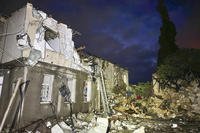Via Stephen Trimble over at the DEW Line blog, is this post from defense analyst James Hasik who makes the case for killing the F-35. As we’ve learned is the cause of most human errors, Gates made his decision to go all-in on the F-35 on the basis of incomplete information, Hasik writes. Now, the F-35 is not justly hugely over budget but development is over a year behind schedule and slowing.
Hasik points to cost as the most obvious F-35 vulnerability. After an eight year absence, deficit hawks have returned to Washington and their budget cutting knives are out. “Any bipartisan commission for balancing the federal budget, as announced just last month, will not be able to avoid recommending military spending cuts, and the JSF is simply the unavoidably biggest part of the investment accounts,” he writes. The F-35 also faces a tough road ahead with the program’s overseas partners who see their own fiscal houses sagging under ominous debt loads.
It’s when Hasik’s analysis ventures into back of the envelope net assessment territory that I find it most compelling. He contends that the F-35 is not militarily vital.
“Several years ago, I asked the head of strategy at a European aircraft manufacturer why his company had no obvious plans for a fighter beyond the current model. “All our customers,” he said, “have enough fighters for chasing Cessnas for the next fifty years.” The next generation of unmanned strike aircraft is alluring, but the air sovereignty mission is just not so compelling today. For frankly, there’s just no threat anywhere that calls for such a huge fleet of land-based fighter aircraft.”
Hasik points out that the Air Force, Navy and Marines combined make up the world’s largest air armada. Then he looks at possible contenders.
Russia:
“The next largest armadas is probably Russia’s, with almost 2200 aircraft. Even if Russia were a plausible opponent, the rest of NATO has its air force outnumbered even without the US on board. And given Russia’s long-term finances and demographics, that number will be shrinking.”
China:
“China’s air fleet is of comparable size—read, smaller than America’s—but it’s also remarkably unimpressive. China’s most numerous jet fighter is a copy of the MiG-21. Then again, one doesn’t fight the Chinese without necessarily having either the Japanese or the Taiwanese—and their significant air forces—on board.”
The rest:
“Sidestepping India (another implausible opponent), the next largest air force is North Korea’s: more than 600 aircraft on paper, but not so many that are flyable or fueled. Besides, South Korea has over 500 aircraft, and of far better quality in men and materiel. Iran? Not half that many flyable machines.”
Hasik figures the U.S. has at least a ten year window before any potential foe could build a fighter fleet that poses a real challenge. Money freed up from the F-35 should go to building a fighter that can best anything the Chinese are likely to build over the next few decades.
As Trimble says, it’s worth a read.
-- Greg









